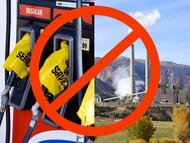Social Cost of Mandates - ORIGINAL CONTENT
- By:
- Edward A. Reid Jr.
- Posted On:
- Jun 13, 2023 at 7:00 AM
- Category
- Energy Policy, Climate Change
Broken Window Economics: an event that seems to be beneficial for those immediately involved can have negative economic consequences for many others.
The US and most countries have energy economies based on fossil fuels, plus contributions from nuclear, hydro, geothermal and biomass. The US and the other OECD (Organisation for Economic Co-operation and Development) countries have announced goals to replace the fossil fuel uses in their economies with renewable generated electricity across the entire spectrum of energy uses. These goals have been accompanied by mandates to eliminate specific fossil fuel end uses for electric generation, to halt the production of internal combustion engine (ICE) vehicles and to replace all fossil fuel end uses by dates certain.
These mandates require the retirement of existing electric generation, vehicle production and appliance production facilities, many before the end of their useful lives and the construction and outfitting of new, replacement facilities. The Biden Administration has argued that these efforts would result in the creation of millions of new, high paying union jobs, though they would also likely result in the elimination of a similar number of similar jobs.
The US currently has a fleet of 200 GW of coal generation capacity, 50 GW of which is scheduled to be retired by the 2030 mandated retirement goal for coal generation. The remaining 150 GW has been scheduled to be retired over the period from 2030 – 2048. Early retirement of these coal plants would strand approximately $35-40 billion of undepreciated private generation assets. It would also strand approximately $30 trillion of coal resources. It is uncertain how the owners of these assets would be compensated for their forced abandonment. Those costs would represent a societal cost of the mandate to close the generating facilities and the resulting abandonment of the coal resources.
The US currently has a fleet of 500 GW of natural gas generation capacity. Approximately 400 GW of that capacity is less than 30 years old, which is a common mid-life for natural gas generators. This suggests that more than 200 GW of natural gas generating capacity would be forced out of service by the 2035 mandated retirement goal for gas generation. Early retirement of these plants would strand another $35-40 billion of undepreciated private generation assets. Again, it is uncertain how the owners of these assets would be compensated for their forced abandonment. These costs would also represent a societal cost of the mandate to close the generating facilities and the resulting abandonment of billions of dollars of natural gas resources and underutilization of natural gas pipeline capacity.
The US also has tens of billions of dollars of automotive manufacturing facilities which the owners would be forced to retire and replace with facilities designed to manufacture EVs and EV batteries, at the same time stranding several billion of dollars of oil resources and oil refining capacity.
Investments in ICE vehicles and natural gas appliances and equipment would be unlikely to be affected by the mandates, since they would likely have outlived their usefulness by 2050.


